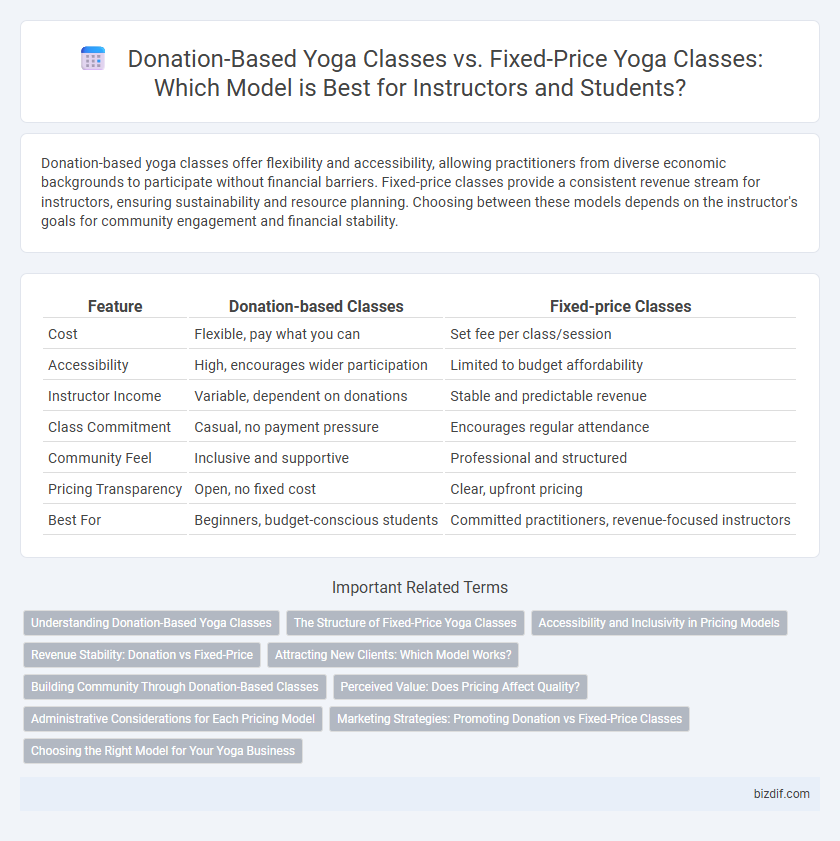Donation-based yoga classes offer flexibility and accessibility, allowing practitioners from diverse economic backgrounds to participate without financial barriers. Fixed-price classes provide a consistent revenue stream for instructors, ensuring sustainability and resource planning. Choosing between these models depends on the instructor's goals for community engagement and financial stability.
Table of Comparison
| Feature | Donation-based Classes | Fixed-price Classes |
|---|---|---|
| Cost | Flexible, pay what you can | Set fee per class/session |
| Accessibility | High, encourages wider participation | Limited to budget affordability |
| Instructor Income | Variable, dependent on donations | Stable and predictable revenue |
| Class Commitment | Casual, no payment pressure | Encourages regular attendance |
| Community Feel | Inclusive and supportive | Professional and structured |
| Pricing Transparency | Open, no fixed cost | Clear, upfront pricing |
| Best For | Beginners, budget-conscious students | Committed practitioners, revenue-focused instructors |
Understanding Donation-Based Yoga Classes
Donation-based yoga classes allow participants to pay what they can afford, fostering inclusivity and accessibility for diverse communities. This model supports instructors through voluntary contributions, often increasing attendance by removing financial barriers. Understanding the flexibility and community-oriented nature of donation-based classes highlights their role in promoting wellness without rigid pricing constraints.
The Structure of Fixed-Price Yoga Classes
Fixed-price yoga classes offer a consistent schedule and set payment amount, providing financial predictability for both instructors and students. This structure allows studios to plan resources, maintain class quality, and implement membership programs or class packs. Students benefit from clear pricing, which can encourage regular practice and commitment to a specific instructor or style.
Accessibility and Inclusivity in Pricing Models
Donation-based yoga classes enhance accessibility by allowing participants to contribute according to their financial ability, fostering an inclusive environment for diverse socioeconomic backgrounds. Fixed-price classes provide predictable revenue for instructors but may limit participation from individuals who find set fees prohibitive. Prioritizing donation-based pricing models supports broader community engagement and removes economic barriers to wellness.
Revenue Stability: Donation vs Fixed-Price
Donation-based yoga classes offer flexible payment options that can attract a broader range of participants but often result in unpredictable monthly revenue due to fluctuating contributions. Fixed-price classes provide consistent income by setting a standard fee, enabling better financial planning and stability for instructors and studios. Revenue stability in fixed-price models supports sustainable business growth, whereas donation-based classes rely heavily on participant generosity and may face cash flow variability.
Attracting New Clients: Which Model Works?
Donation-based yoga classes often attract new clients by lowering financial barriers, encouraging trial and fostering community engagement. Fixed-price classes provide structured pricing that may appeal to clients seeking clear cost expectations and perceived value. Offering flexible payment options combining both models can optimize client acquisition and retention in competitive yoga markets.
Building Community Through Donation-Based Classes
Donation-based yoga classes foster a strong sense of community by removing financial barriers and encouraging participation from diverse individuals. Participants often feel more connected and engaged when they contribute based on their means, promoting inclusivity and mutual support. This model cultivates a welcoming environment where shared energy and collective growth outweigh rigid pricing structures.
Perceived Value: Does Pricing Affect Quality?
Donation-based yoga classes often emphasize accessibility and community support, allowing participants to pay what they can, which can enhance perceived value through inclusivity and personalized intention. Fixed-price classes convey consistent pricing that may signal professionalism and quality assurance, influencing participants to associate cost with instructor expertise and facility standards. Perceived value is shaped more by instructor credentials, class content, and environment than by pricing models alone, as quality perception integrates tangible and intangible factors beyond cost.
Administrative Considerations for Each Pricing Model
Donation-based yoga classes require streamlined administrative processes to track variable income and ensure transparent financial reporting, often relying on digital payment systems for ease of collection. Fixed-price classes demand structured registration systems to manage consistent payments, allocate resources efficiently, and forecast revenue accurately. Both models benefit from clear record-keeping and compliance with local tax regulations, but fixed-price setups generally necessitate more comprehensive software solutions for subscription and attendance management.
Marketing Strategies: Promoting Donation vs Fixed-Price Classes
Marketing strategies for donation-based yoga classes emphasize community engagement and value exchange, often leveraging social proof, storytelling, and social media to highlight accessibility and inclusivity. Fixed-price class promotions focus on clear pricing, packages, and membership benefits, using targeted ads and email marketing to drive consistent revenue and customer retention. Both approaches benefit from testimonials and well-crafted calls-to-action tailored to their respective audience motivations and financial expectations.
Choosing the Right Model for Your Yoga Business
Donation-based classes foster community connection and accessibility, encouraging students to pay what they can and attracting a diverse clientele. Fixed-price classes provide predictable revenue streams that support consistent business planning and investment in quality instruction and facilities. Evaluating your target audience's financial capacity and your business sustainability goals will help determine the optimal pricing model for your yoga enterprise.
Donation-based Classes vs Fixed-price Classes Infographic

 bizdif.com
bizdif.com